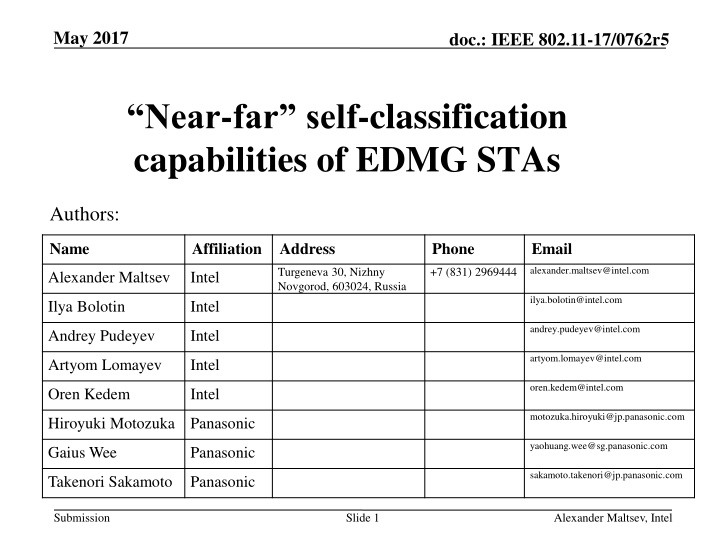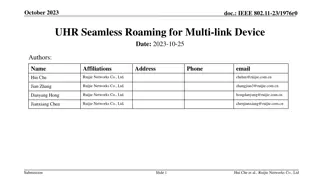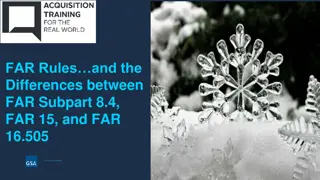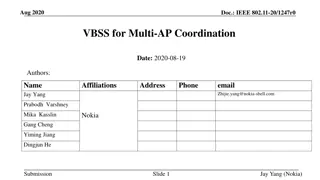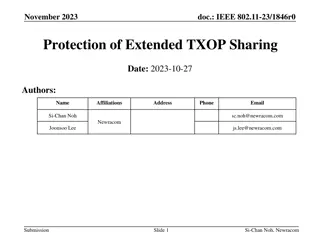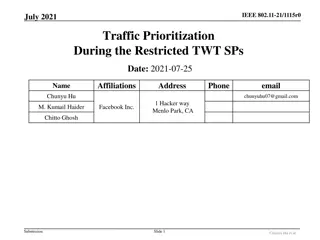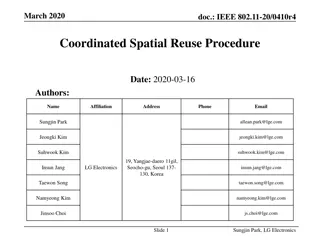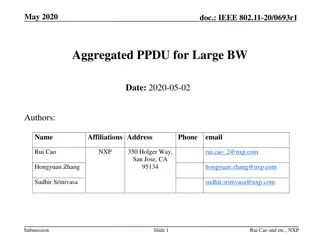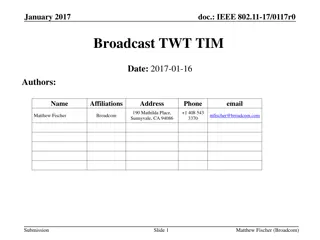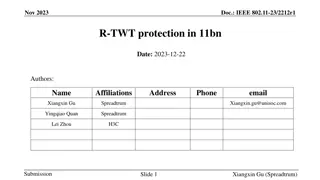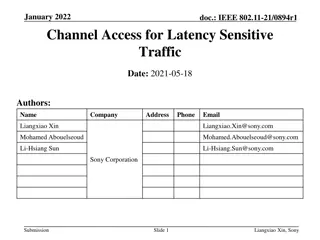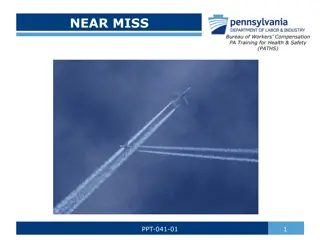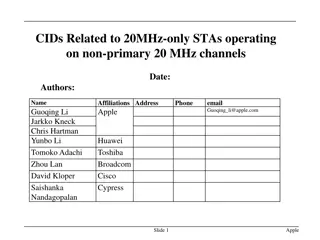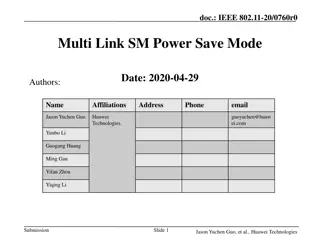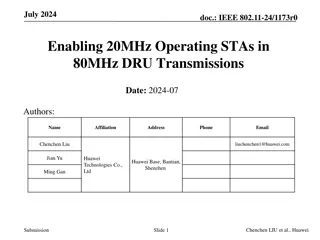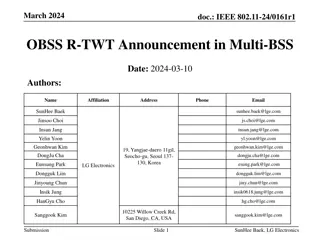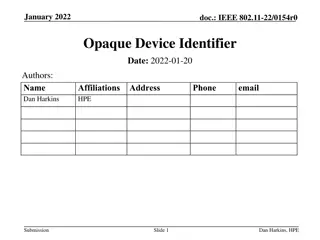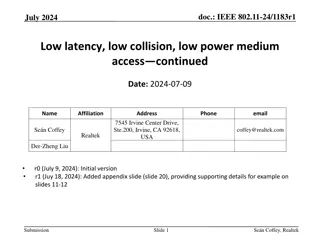Near-far Self-Classification Capabilities of EDMG STAs
The document discusses the problem of near-far self-classification capabilities for EDMG STAs in IEEE 802.11-17/0762r5. It focuses on sorting STAs based on range and capabilities to prevent unnecessary transmissions and interference. The AP provides information for STAs to determine whether to use legacy procedures or directional transmission-reception methods. Criteria for classifying STAs as near are outlined, considering various parameters and conditions.
Download Presentation

Please find below an Image/Link to download the presentation.
The content on the website is provided AS IS for your information and personal use only. It may not be sold, licensed, or shared on other websites without obtaining consent from the author.If you encounter any issues during the download, it is possible that the publisher has removed the file from their server.
You are allowed to download the files provided on this website for personal or commercial use, subject to the condition that they are used lawfully. All files are the property of their respective owners.
The content on the website is provided AS IS for your information and personal use only. It may not be sold, licensed, or shared on other websites without obtaining consent from the author.
E N D
Presentation Transcript
May 2017 doc.: IEEE 802.11-17/0762r5 Near-far self-classification capabilities of EDMG STAs Authors: Name Affiliation Address Phone Email alexander.maltsev@intel.com Turgeneva 30, Nizhny Novgorod, 603024, Russia +7 (831) 2969444 Alexander Maltsev Intel ilya.bolotin@intel.com Ilya Bolotin Intel andrey.pudeyev@intel.com Andrey Pudeyev Intel artyom.lomayev@intel.com Artyom Lomayev Intel oren.kedem@intel.com Oren Kedem Intel motozuka.hiroyuki@jp.panasonic.com Hiroyuki Motozuka Panasonic yaohuang.wee@sg.panasonic.com Gaius Wee Panasonic sakamoto.takenori@jp.panasonic.com Takenori Sakamoto Panasonic Submission Slide 1 Alexander Maltsev, Intel
May 2017 doc.: IEEE 802.11-17/0762r5 Problem statement In accordance with Candidate Draft P802.11ay_D0.3 in beamforming procedure for the asymmetric link each STA tries to perform negotiation in A-BFT and then, if it fails, STA performs negotiation in Beamforming training (BFT) allocation during the DTI. Thus the far away EDMG STAs in new outdoor dense deployment scenario will perform a lot of useless transmissions in A-BFT producing undesirable collisions and interference. Therefore, it is desirable to sort the STAs by its range and capabilities, and separate the EDMG STAs that can be served with the legacy procedure (negotiation in A-BFT and access in legacy allocations) from the EDMG STAs that can be served only by using the directional transmission-reception. Submission 2 Alexander Maltsev, Intel
May 2017 doc.: IEEE 802.11-17/0762r5 Near-far self- classification (1/3) The AP should provide its capabilities to the STAs. With knowledge of the AP parameters, its own parameters and RSSI measurements, the EDMG STA can decide, whether its transmitted signal can be reliably received by the AP in quasi-omni mode (in A-BFT and legacy allocations), or it should try to negotiate during the BFT allocation. The EDMG STA can go through the legacy procedure (negotiation in A- BFT and access in legacy allocations) if the inequality (2) below is satisfied: (1) Pathloss = PAPtx +GAPtx +GSTArx - RSSI STA Meas ured by STA Given by AP parameter PAPrx=PSTA+GSTAtx +GAPomni_rx - Pathloss >PAPsensitivity (2) Calculated using equation (1) Given by AP Given by AP STA parameters Submission 3 Alexander Maltsev, Intel
May 2017 doc.: IEEE 802.11-17/0762r5 Near-far self- classification (2/3) Substituting (1) in (2) we obtain PAPrx = PSTA+GSTAtx +GAPomni_rx - PAPtx - GAPtx -GSTArx + RSSI >PAPsensitivity We can denote PAPsensitivityas follows: PAPsensitivity= Pmin_sensitivity- GAPadd_gain where Pmin_sensitivityis the receiver sensitivity in 11ad, and GAPadd_gainis additional sensitivity gain at the receiver of theAP (due to specific implementation) The final condition to classify STAas near looks like: (3) PAPrx = (EIRPSTA GSTArx)+ RSSI - (EIRPAP - GAPomni_rx - GAPadd_gain) >Pmin_sensitivity Measured by STA Provided by AP to STA Defined in 802.11ad STA parameter Submission 4 Alexander Maltsev, Intel
May 2017 doc.: IEEE 802.11-17/0762r5 Near-far self- classification (3/3) To implement this solution in the standard, the DMG Beacon frame, broadcasted by AP in BTI, should contain the quantized value for PCP/AP Coverage Parameter: PCP/AP Coverage Parameter = (EIRPAP GAPomni_rx GAPadd_gain) (4) 3 bits of the SSW field in the DMG Beacon (see Figure 47, in Candidate Draft P802.11ay_D0.3) may be able to contain the quantized value (4): Codes 0-7: 14 42 dBm (4 dB quantization step) B19 B22 B0 B1 B9 CDOWN Sector ID DMG Antenna ID Quasi-omni TX PCP/AP Coverage Parameter Reserved B10 B15 B16 B17 B18 B23 Direction 3 Bits 1 9 6 2 1 2 NOTE: as far as antenna gain values in (4) may vary depending on the direction, the value of PCP/AP Coverage Parameter may be sector-specific Submission 5 Alexander Maltsev, Intel
May 2017 The behavior of EDMG STA with near- far self- classification capability doc.: IEEE 802.11-17/0762r5 TRUE - EDMG STA classifies itself as a nearSTA DMG Beacon frame reception in BTI Check if NO Check Access A-BFT is present in current BI inequality (1) YES SSW feedback was received R-TXSS in A-BFT SSW feedback was not received FALSE - EDMG STA classifies itself as a farSTA Check if BFT allocation or Directional allocation were scheduled for current BI Asymmetric beamforming training in BFT allocation / access in Directional allocation YES NO Transmission to PCP/AP is forbidden Submission 6 Alexander Maltsev, Intel
May 2017 doc.: IEEE 802.11-17/0762r5 SP/M #1 Do you agree to include the text for Near-Far self- classification capabilities of EDMG STAs proposed in (11- 17-0764-02-00ay-text-near-far-self-classification- capabilities-of-edmg-stas) to the spec draft? Submission 7 Alexander Maltsev, Intel
May 2017 doc.: IEEE 802.11-17/0762r5 BACKUP Submission 8 Alexander Maltsev, Intel
May 2017 AP Coverage Parameter range estimation doc.: IEEE 802.11-17/0762r5 AP Coverage Parameter = (EIRPAP GAPomni_rx GAPadd_gain) EIRPAP GAPomni_rx Upper limit: FCC requirements for 60GHz - EIRP < 43dBm. GAPomni_rx> 0 Lower limit: the 11ad standard defines the maximal difference between peaks of directional and quasi-omni patterns as 15 dB (20.10.1 of 11mc). We are confident that for 11ay, where the large antenna arrays will be used, this difference will be higher: GAP GAPomni_rx> 15dB => EIRPAP GAPomni_rx> 20dBm GAPadd_gain Upper limit: this parameter is the gain over the sensitivity defined in Table 20-3. The values in that table were obtained under assumption of 5 dB implementation loss and 10 dB noise factor. So, the theoretical maximum of GAPadd_gainis 15dB. However, we are confident, that, in reality, this value will not be more than 6dB. GAPadd_gain< 6dB Lower limit: the value is definitely positive as otherwise it will not satisfy the minimal sensitivity defined in Table 20-3. GAPadd_gain> 0dB 14dBm < (EIRPAP GAPomni_rx GAPadd_gain) < 42dBm Submission 9 Alexander Maltsev, Intel
May 2017 AP antenna gain value mismatch impact doc.: IEEE 802.11-17/0762r5 GAPtxconsidered in this proposal is a peak AP antenna gain There will be cases where the signal was received by STA not in the peak gain. So, the value, provided by AP (GAPmax), will be higher than actual value (GAPtx= GAPmax GAP_mismatch). Actual antenna gain GAP_mismatch PAPrx = (EIRPSTA GSTArx)+ RSSI (G GAPtx APtx+ +G GAP mismatch + AP_ _mismatch Antenna gain provided by AP STA +PAPtx GAPomni_rx GAPadd_gain) >Pmin_sensitivity The AP antenna beamforming mismatch leads to the overestimation of Pathloss in equation (1) and, therefore, can be considered as an additional margin for criterion (3). So, STA will define itself farther than it actually is. The reduction of this effect may be done by proper correction of AP Coverage Parameter. Submission 10 Alexander Maltsev, Intel
